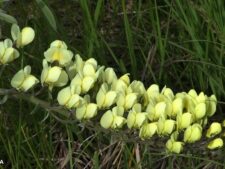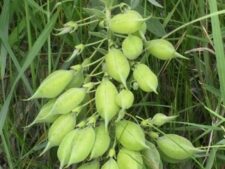
PLAINS WILD INDIGO
Baptisia bracteata
BEAN FAMILY (Fabaceae)
 Identification
Identification
- Flowering time - May, June
- Rare in prairies at NW
- Showy, drooping pea-like flower cluster
- Leaves divided into 3 leaflets
- Creamy-yellow flowers, drooping flower stalks and hairy foliage separate this plant from White Wild Indigo (Baptisia alba var. macrophylla).
This hairy, native perennial grows 1-2 feet tall. The spreading branches have alternate compound leaves which are divided into 3 elliptic leaflets (C). Large creamy-yellow pea-like flowers occur in long, showy clusters at the ends of drooping flower stalks (A,B). The flowers are replaced by pale green, beaked seed pods that turn black as they mature (D).
Found in well drained prairie sites, flowering in May and June. At Neale Woods it is rare with a single small population in the prairie restoration just across the path from the old green Astronomy Building.
The creamy-yellow flowers, drooping flower stalks and hairy stem and leaves separate this plant from White Wild Indigo (Baptisia alba var. macrophylla).
Species of Baptisia were once used to make a poor quality indigo dye, hence the name which is derived from a Greek word meaning “to dye.” Local Native Americans used the seed pods as rattles. This plant is poisonous, but distasteful and usually avoided by livestock.
Other common names include Black Rattle-pod, Cream, Large or Long-bracted Wild Indigo and Cream or Yellowish False Indigo.
The content of NatureSearch is provided by dedicated volunteer Naturalists of Fontenelle Forest who strive to provide the most accurate information available. Contributors of the images retain their copyrights. The point of contact for this page is: Neal Ratzlaff.



